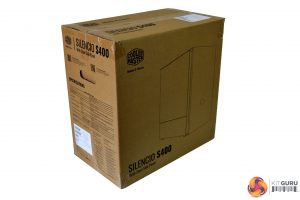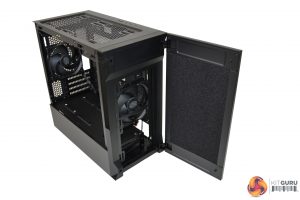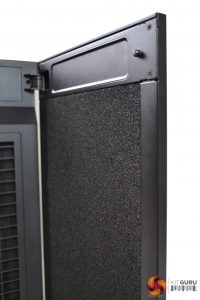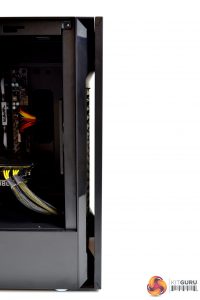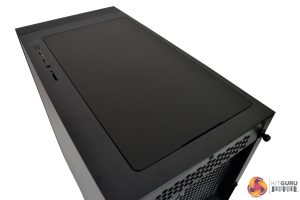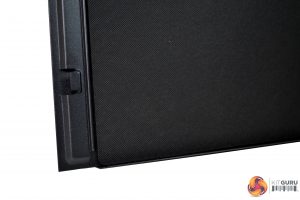Cooler Master have packaged the Silencio S400 in a brown cardboard box. On the front, towards the right-hand side, there is a large image of the case with the Cooler Master logo in the top-left corner.
Once removed from the box, we can see the S400 is well packaged, with thick polystyrene protecting the top and bottom of the case. Beneath the polystyrene, a plastic bag wrapping covers the whole product.
Cooler Master has kindly provided us with the alternative tempered glass side panel, which will give us more options during testing. This also arrives in a brown cardboard box with a plastic carry handle. The tempered glass panel is well protected, with thick foam covering and anti-scratch film applied to both sides.
Included in the box with the case is a mesh top filter, which can be used as an alternative for the top silent panel. A user manual and warranty card are also supplied along with a bag of assorted screws, tool free HDD fixings and rubber anti-vibration grommets.
With an extremely minimalist design, the S400 shouldn’t look out of place in any environment, we would expect it to be used mainly in builds suited to office type scenarios but you could of course use it for a gaming PC as well.
The front of the case had a full-length door that is hinged on the right-hand side, with a magnetic catch and rubber stoppers to the left. If needed, you can hang the door on the opposite side by simply removing the four hinge screws and the screws in the rubber stoppers, and switch them around – very simple.
The door is primarily constructed from steel, with what appears to be a dense sponge material covering the back in an attempt to dampen noise exiting the case. Behind the door is a front panel, featuring a re-curved vent, which directs air flow from the sides and bottom with minimised turbulence. Removal of the vent offers unobstructed access to the fans.
Behind the door, there is a 5.25” optical drive bay which isn’t a common feature nowadays, but there are some mere mortals that still use optical drives so this will please them. The 5.25” drive bay can also be used to mount a 3.5” HDD or can be completely removed, by unscrewing the four fixing screws.
The front panel, including the door, can be removed in one piece; a sharp pull from the bottom edge will release it from its plastic clips. Removal of the front panel reveals one of the two pre-installed FP120 PWM fans.
A feature of the front panel is air-flow enhancing slots to the sides and bottom, which are approximately 12mm wide.
Along the top of the case is the I/O panel. The first things to note are the power button, in the shape of the Cooler Master logo, and ghd rectangular reset button. The power button is lit up with an LED, indicating power is on, and the reset button has a small LED, indicating storage activity. There are two USB 3 ports, a four-pole 3.5mm audio jack and SD card reader which is a handy addition.
The top of the case is covered by a solid panel, to reduce noise, and this sits on top of the two 120mm/140mm fan mountings. This panel can be replaced with an included mesh filter, to use when installing fans or a radiator in the top section.
The left-hand side of the case is split into two separate sections. The top section is the removable steel (or glass depending on configuration) side panel. Beneath this, the bottom section is actually the PSU shroud which is permanently fixed in-place. We quite like this idea as it breaks up the side, giving it a little style and makes the PSU area a little less congested.
Both right and left steel side panels are covered in thick sound dampening materials to precisely counter the most prominent frequencies coming from inside the case.
On the rear of the case, we see a typical layout – PSU mounting at the bottom, four PCI-e slots, I/O shield cut out, a 120mm/140mm fan mount, and a narrow ventilation grille right at the top. The underside of the case has four silver feet, with rubber soles, a removable mesh filter covering the PSU fan position, and various cut-outs for the 3.5” HDD cage, which mounts on the floor inside.
The overall build quality of the exterior is good – the steel may be on the thin side, but it does have a quality, sturdy feel to it, even when the side and front panels are removed. The black coating, which is applied evenly, is well matched between the steel and plastic parts.
 KitGuru KitGuru.net – Tech News | Hardware News | Hardware Reviews | IOS | Mobile | Gaming | Graphics Cards
KitGuru KitGuru.net – Tech News | Hardware News | Hardware Reviews | IOS | Mobile | Gaming | Graphics Cards


